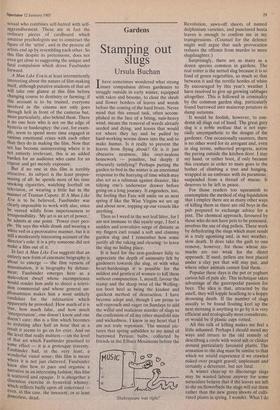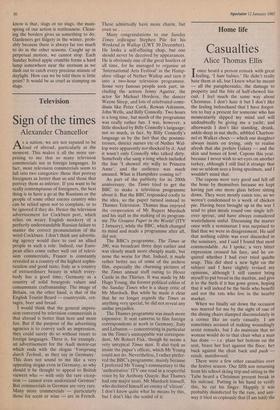Gardens
Stamping out slugs
Ursula Buchan
T have sometimes wondered what strong .11-inner compulsion drives gardeners to struggle outside in early winter, equipped with rakes and besoms, to clear the shrub and flower borders of leaves and weeds before the coming of the hard frosts. Never mind that this annual task, often accom- plished in the face of a biting, rain-heavy wind, means the removal of weeds already seeded and dying, and leaves that would rot where they lay and be pulled by hard-working worms down into the soil to make humus. Is it really to prevent the leaves from flying about? Or is it just obsessive neatness, like over-zealous housework — pointless, but deeply if obscurely satisfying? Perhaps putting the garden to bed in the winter is an emotional response to the hurrying of time which may also act as a talisman against disaster, like tidying one's underwear drawer before going on a long journey. It engenders, too, the feeling that Fate will smile on us next spring if like the Wise Virgins we are up and about now, topping up our vessels like anything.
Then as I weed in the wet leaf litter, for I am not immune to this yearly urge, I feel a sudden and convulsive surge of distaste as my fingers curl round a soft and clammy garden slug and I remember how some justify all the raking and clearing: to leave the slug no hiding place.
It is hard for the non-gardener fully to appreciate the depth of animosity felt by gardeners towards the slug, or with what heart-hardenings it is possible for the mildest and gentlest of women to kill them without compunction. I, myself, favour the stamp and the sharp twist of the Welling- ton boot heel as being the kindest and quickest method of destruction. I have become adept and, though I am prone to self-reproach and eager on Sundays to add the wilful and malicious murder of slugs to the confession of all my other manifold sins and wickedness, I know in my heart that I am not truly repentant. The mental pic- tures that spring unbidden to my mind of burrowed Persian bulbs, collected by friends in the Elburz Moubtains before the
'Shakespeare was right!'
Revolution, sawn-off shoots of named delphinium varieties, and punctured hosta leaves is enough to confirm me in my transgressions. (Counsel for the defence might well argue that such provocation reduces the offence from murder to mere slugslaughter.) Surprisingly, there are as many as a dozen species common in gardens. The real rotter is the netted slug because it is so fond of green vegetables, so much so that between it and the terrific hordes of white fly encouraged by this year's weather I have resolved to give up growing cabbages altogether. This is followed in criminality by the common garden slug, particularly found burrowed into maincrop potatoes in damp autumns.
It would be foolish, however, to con- demn all slugs out of hand. The great grey slug is a noble mollusc that is not espe- cially unsympathetic to the designs of the gardener. One occasionally saunters, there is no other word for its arrogant and, even in slug terms, unhurried progress, across the paving outside the kitchen door. I stay my hand, or rather boot, if only because this creature in order to mate goes to the bother of climbing a tree and hanging, wrapped in an embrace with its paramour, suspended from a thread of mucus. It deserves to be left in peace.
For those readers too squeamish to contemplate the method of slug liquidation that I employ there are as many other ways of killing them as there are old boys in the pub prepared to exchange advice for a pint. The chemical approach, favoured by those who do not have pets to be poisoned, involves the use of slug pellets. These work by dehydrating the slugs which must result in a truly agonising and, in wet weather, slow death. It does take the guilt to one remove, however, for those whose sto- machs are too weak for the direct approach. If used, pellets are best placed under a clay pot that will stay put, and where other animals cannot find them. Popular these days is the pot or yoghurt carton full of pale ale. This technique takes advantage of the gastropodal passion for beer. The idea is that, attracted by the smell, they will topple headlong to a hoppy drowning death. If the number of slugs usually to be found floating keel up the next morning is anything to go by it is very efficient and ecologically most considerate, or would be if plastic cups rotted.
All this talk of killing makes me feel a little ashamed. Perhaps I should mend my ways and return to the old remedy of describing a circle with wood ash or clinker around particularly favoured plants. The sensation to the slug must be similar to that which we would experience if we crawled naked over peagrit gravel; unpleasant and certainly a deterrent, but not fatal.
A winter clear-up to discourage slugs may be wasted labour anyway for some naturalists believe that if the leaves are left to die on flowerbeds the slugs will eat them rather than the new green shoots of culti- vated plants in spring. I wonder. What I do know is that, slugs or no slugs, the main- spring of our action is restlessness. Clean- ing the borders gives us something to do. Gardeners get fidgety in the winter, prob- ably because there is always far too much to do in the other seasons. Caught up in perpetual motion, we cannot stop. Each Sunday bolted apple crumble forms a hard lump somewhere near the sternum as we dash out to catch every precious minute of daylight. How can we be told there is little point? It would be as cruel as stamping on slugs.







































 Previous page
Previous page